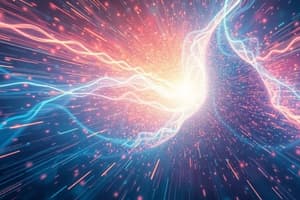Podcast
Questions and Answers
Which state of matter has a fixed volume but can change shape?
Which state of matter has a fixed volume but can change shape?
- Gas
- Liquid (correct)
- Solid
- Plasma
What describes the motion of particles in a solid?
What describes the motion of particles in a solid?
- Particles are freely moving and occupy any space.
- Particles are stationary and do not vibrate.
- Particles vibrate in place without leaving their structure. (correct)
- Particles move past each other with ease.
How do gases differ from solids and liquids in terms of shape and volume?
How do gases differ from solids and liquids in terms of shape and volume?
- Gases cannot change shape but can change volume.
- Gases have a fixed volume but change shape.
- Gases have a fixed shape and fixed volume.
- Gases can change both shape and volume. (correct)
What is the primary characteristic that distinguishes solids from liquids?
What is the primary characteristic that distinguishes solids from liquids?
What happens to the kinetic energy of particles as their motion increases?
What happens to the kinetic energy of particles as their motion increases?
Which statement about the particles in a gas is true?
Which statement about the particles in a gas is true?
What type of energy do particles in all states of matter possess?
What type of energy do particles in all states of matter possess?
Which condition correctly describes liquids?
Which condition correctly describes liquids?
How are the particles in a solid arranged compared to those in a liquid?
How are the particles in a solid arranged compared to those in a liquid?
Which statement accurately describes the kinetic energy of particles in solids?
Which statement accurately describes the kinetic energy of particles in solids?
What property of liquids distinguishes their particle arrangement from that of gases?
What property of liquids distinguishes their particle arrangement from that of gases?
How do the particle attractions in gases compare to those in liquids?
How do the particle attractions in gases compare to those in liquids?
Why does ice float on water?
Why does ice float on water?
Which statement best describes the motion of particles in gases?
Which statement best describes the motion of particles in gases?
What unique density characteristic does water exhibit?
What unique density characteristic does water exhibit?
Which of the following best describes the arrangement of particles in solids?
Which of the following best describes the arrangement of particles in solids?
What is one important ecological role of ice in the Earth’s system?
What is one important ecological role of ice in the Earth’s system?
Flashcards are hidden until you start studying
Study Notes
States of Matter
- Solids, liquids, and gases are classified by their ability to change shape and volume.
- Solids have a fixed shape and volume.
- Liquids have a fixed volume but can change shape.
- Gases can change both shape and volume.
- All matter is made up of tiny, moving particles.
- The particles in a substance are the same in its solid, liquid, and gaseous forms.
- Particles in matter can be molecules, atoms, or a subunit of an atom.
- Different states of matter have different levels of particle motion.
- The particles in a substance have more motion in a gas than in a liquid, and more motion in a liquid than in a solid.
- The rock and the flowing lava are made of the same kind of particles.
- Kinetic energy is the energy of motion.
- The particles in matter have kinetic energy.
- The particles in matter are in constant motion (even in solids).
- As particle motion increases, kinetic energy also increases.
- Particles in solids are in a structured pattern and vibrate in place.
- Particles in liquids can move past each other but maintain contact.
Gases
- Particles are far apart and move rapidly, randomly, and in all directions.
- Collisions between particles are infrequent due to the large distances between them.
- Gases have high kinetic energy, meaning particles move quickly.
- Particle attraction has minimal influence on their movement.
Liquids
- Particles are close together but not rigidly arranged, allowing them to move past each other.
- They experience stronger interparticle attraction than gases, influencing their movement and flow.
- Liquids exhibit moderate kinetic energy, representing a balance between fast-moving particles and attractive forces.
Solids
- Particles are tightly packed in a fixed arrangement.
- Particles vibrate in their fixed positions due to strong interparticle attraction keeping them bound in a rigid structure.
- Solids have the strongest interparticle attraction, holding particles in place and limiting their movement.
- Solids have low kinetic energy, as particles have minimal motion.
Water's Unusual Density
- Water's density pattern deviates from other substances, exhibiting an unusual characteristic where its solid state (ice) is less dense than its liquid state.
- Ice molecules form a specific repeating pattern, creating open spaces between particles.
- This spacing between particles in ice results in lower density than liquid water, causing ice to float.
Importance of Ice
- Ice plays a crucial role in the Earth's system, impacting the hydrosphere, atmosphere, biosphere and providing habitats.
- The hydrosphere, which includes oceans, lakes, and rivers, is largely covered by ice.
- Ice interacts with the atmosphere, influencing weather patterns and global climate through processes like reflection of sunlight and storage of heat.
- Ice provides habitats for numerous species, including penguins, polar bears, and walruses.
Studying That Suits You
Use AI to generate personalized quizzes and flashcards to suit your learning preferences.




